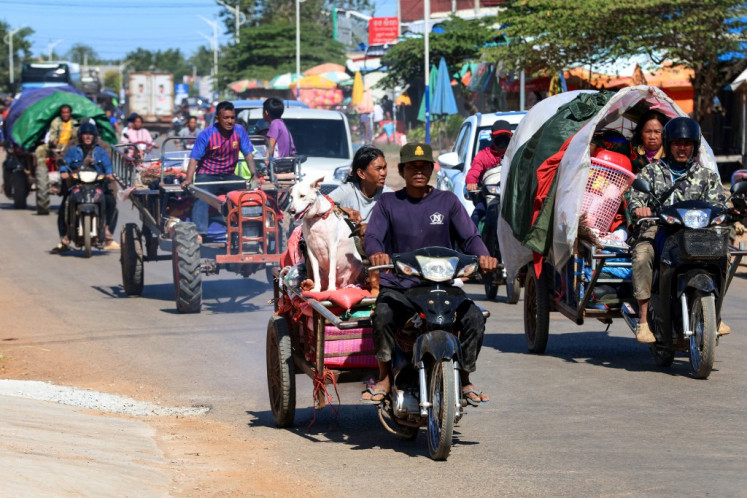Popular Reads
Top Results
Can't find what you're looking for?
View all search resultsPopular Reads
Top Results
Can't find what you're looking for?
View all search resultsThe children of the dump
On the periphery: A child wanders through the area near his home in Bantar Gebang, Jakarta’s waste dump
Change text size
Gift Premium Articles
to Anyone
On the periphery: A child wanders through the area near his home in Bantar Gebang, Jakarta’s waste dump.
For the scavenger children of Indonesia’s largest rubbish dump, building a career outside the place may be a life ambition harder won than for many others.
But that hasn’t stopped 11-year-old Bantar Gebang local Nurafidah, who spends her mornings in school and her afternoons sorting plastic, from dreaming of becoming a chef.
“I want to reach my goals. I want to be successful and help my parents build their own home, and have my own home one day,” she says.
She is not alone. Many children of the dump are sure they want to be doctors, midwives and in the police force. Some hope to be in the military, others want to be singers.
Littered: Detritus is scattered on the ground at Bantar Gebang. Some children being raised there have high hopes for their future, others see their home there, at the rubbish dump.Bantar Gebang, 30 kilometers from the city, is Jakarta’s dump — a 110-hectare area that receives about 800 trucks off-loading 6,250 tons of rubbish from the capital every day.
Twenty-four years ago, the site was paddy fields. Now, it is still farmland, but not in the traditional sense. Emaciated goats graze the several-stories-high pile of rubbish coined “the mountain” by locals, industrial machinery digs the land for recyclables and the crop provides an income for the 5,000 people who call Bantar Gebang home.
Families live in slums on the periphery of “the mountain” in one- or two-room makeshift shacks fashioned from scrap wood, rugs and old plastic advertisements, their houses blending seamlessly into the landscape.
The workers are mostly unskilled from Java, and have spent much of their lives scavenging on the streets or in garbage bins. At Bantar Gebang, they proudly sort and lay out their treasured finds of the day — aluminum tins, plastics and glass bottles, which are then sold to the nearby factory for recycling.
Nurafidah is among the luckier of Bantar Gebang’s children. She receives four-and-a-half hours of schooling every day at Yayasan Dinamika Indonesia (YDI), the only school at Bantar Gebang specifically for children from scavenging families.
Teacher and school social worker Oman Setiawan says their intention is to overcome or minimalize child labor at the dump, or at least reduce their working hours.
At YDI pupils are apparently unaware of the scorching sun, flies buzzing and stench from the waste heaps on the periphery of the school. They sing songs, draw pictures and intently study multiplication tables. Like children from all over the world, the boys chase each other around the courtyard and the girls teach each other clapping games.
“I love going to school to learn and spend time with friends,” says 10-year-old pupil Listin, who wants to be a doctor. “I want to reach my goals and become a smart kid.”
But while about 500 children attend one of the schools there, there are 1,000 other children in the community that do not and never will, as they are all working.
Schooled: These children from Bantar Gebang are fortunate enough to attend school. About 1,000 of the children being raised at Jakarta’s rubbish dump do not.
From the age of five, most of YDI’s children spend the afternoon working alongside their parents, sorting and shredding plastic, cutting cans, packing and picking rubbish directly from the heaps. The children of migrants to Bantar Gebang work in the trash heaps, while children of local families are more likely to be preparing material for resale.
By the age of 10, many children will have stopped attending school to work full-time in the landfill. What the children earn is vital income for the family, between Rp 20,000 (US$2) and Rp 50,000 rupiah a day.
YDI was set up in 1995 by the International Program for the Elimination of Child Labor (ILO-IPEC) with a basic education program tailored to the needs of child trash pickers. The government and regular donors fund the school.
YDI’s educates more than 250 children aged 7 to 12 in the mornings with the same curriculum taught in the rest of the country — Indonesian, mathematics and geography.
Oman says because there is considerable variation in education levels between children, they are not placed in classes according to age.
“In our school, there are some children who should have been in junior high but are still at the primary level,” Oman says.
He says formal schooling would not work for these children, as it was hard to get parents to help their children study at home due to illiteracy and long working hours. Families also relied on their children to work in the afternoons.
“Because of this, there is a greater risk of children dropping out. That is why we exist.”
Oman says many do leave the dump after they have had some schooling to find other ways to earn money.
At play: Children pass the time at the only school at Bantar Gebang specifically for children from scavenging families, Yayasan Dinamika Indonesia (YDI).
“Many say they want more viable work and do not want to live as scavengers like their parents. They want to be doctors, midwives and in the military.
“There are many children who are not working as scavengers anymore. They work at companies like Labor Indonesia, in security, as garbage truck drivers,” he says.
But for some children, once they know the money that can be made from working at the dump, they often want to leave school and scavenge into adulthood. Children start to quit school at about the third grade, when they think they are literate enough and need to contribute to their families’ income.
Although they have their dreams, some of the children would not leave the dump, Oman says. It is where they were raised and where their families live.
Ten-year-old Riyandi, a YDI pupil who was born at Bantar Gebang, says while he dreams of becoming a policeman one day, he wants to stay at the garbage dump into adulthood.
“It is my home. I want to stay here and have a family,” Riyandi says.
— Photos By JP/Mary Baines













